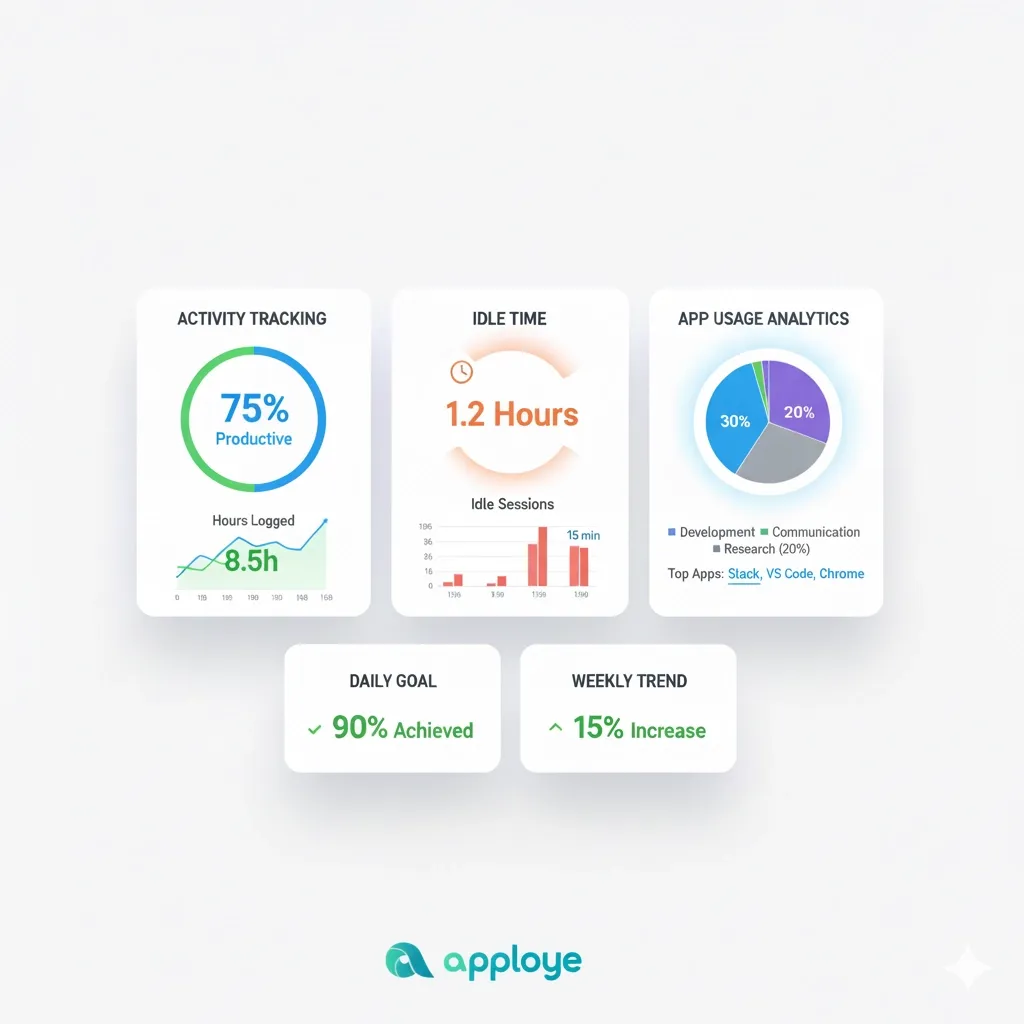13 Early Signs Of Employee Disengagement: How to Overcome Strategically!

Summary:
-
Disengagement grows quietly, and spotting early signs like lower productivity or social withdrawal helps prevent long-term fallout.
-
One-on-one talks and feedback follow-ups reveal hidden issues behind low motivation or poor performance.
-
Supportive culture, fair reviews, and hybrid work options rebuild trust and purpose.

Real-time insights into activity and attendance make detecting and addressing disengagement easier.
For more than a year, I’ve seen employees fading away from their actual cheerful selves. Deadlines slip, enthusiasm fades, and meetings become quieter.
And the worst part is that it hardly happens overnight. There will be signs of disengagement, and if you’re aware, you will notice them!
In this guide, we’ll break down the subtle behavioral and tactical signs of employee disengagement, why they matter, and how managers can act before motivation truly disappears.
In this article
13 Signs to Watch Out for to Identify Employee Disengagement
From productivity level reduction to maintaining social distance, here are our top 13 signs of disengagement you need to keep an eye out for:
Reduced Productivity
Let’s say you had an employee who delivered optimum quality output within the given time period. But gradually, that person is no longer providing the same kind of result, or the work seems rushed. It indicated that the employee is no longer engaged in his work.
Often, however, this can result from issues in the department he’s working in, or it may be due to stress or other personal reasons. Whatever the reason is, the reduction of employee productivity is directly related to disengagement.
Track productivity trends with real-time data
Failing to Meet Deadlines
Submitting work within the given deadline is a vital skill for any employee, especially while working with a team. When you see that an employee who has mostly never missed deadlines is repeatedly asking for extensions, it may be a sign that the employee is disengaged.

Of course, there may be valid reasons for not being able to submit work on time, but to have a proper understanding of the situation, you will have to communicate thoroughly.
Monitor project hours to catch delays early
Delivering Poor-quality Works
Did you suddenly notice that some of your employees are delivering low-quality submissions? Well, there can be many reasons behind that, but you should consider disengagement as a probable reason.
When the heart is not in the work, your code will have more bugs, and designs will carry off-angle alignment and more. So, try to figure out what the actual issues are with your employees!
Keeping Distance from Colleagues
Suppose an employee, who previously socialized with the team and chipped in on team dinners, is no longer doing any of these. In that case, that's a sign of social withdrawal.
Although note the fact that lack of involvement doesn't necessarily mean degradation of workplace relationships, as it can be a personality trait. But if a regular social person has suddenly distanced himself from others, then that’s a situation you need to look into.
Why Is Collaboration Important
Participating in Meetings for the Sake of It
An employee who used to be the soul of team meetings, one day, just got quiet. No inputs, no discussions, just keeping shut in all the meetings. That’s a clear sign of feeling disengaged from the work environment.
Quiet quitting is something that you don’t need to hear. That silence in meetings speaks louder than any symptoms of disengagement.
Taking More Breaks than Usual
If you find an employee who's taking breaks more than usual, at odd times, and providing work that doesn't match the quality that's needed, it may be a clear sign of disengagement.
Most often, a disengaged employee may be unavailable at his desk at an unusual time, or simply under-deliver intentionally.
If you see an employee sitting at the desk but not promptly responding to emails or texts, then you will need to look further into the matter to determine the cause behind it.
See activity patterns and idle time instantly
Having Paid Time Off Without Notice
One active sign of disengagement is taking too many sick days or unplanned time off, without giving any prior notice. This usually means that the employee is deliberately avoiding work.
You also have to keep in mind that there may be genuine reasons behind taking leave too often, as the physical and mental health of a person is important to take care of. Try to open up with them and see how the communication flows. A few words of care can go a long way.
Track attendance and spot absence patterns
Radiating a Negative Aura
You’ll know that some employees are demotivated and disengaged when rumors start to spread about work culture and management. Moreover, disengaged members more often than not let their guards down and share negative comments about the company physically or on social media.
That’s when you’ll know who’s the troublemaker and how you should approach it. Before they start to disturb the team morale, address the issues and confront them!
Ignoring Major Work Policies
Taking sudden leaves, coming late to the office, and breaking the code of conduct are not regular things for an employee. If an employee is intentionally doing that without caring, then you should safely assume it’s a sign of detachment.
Employee performance depends on how diligent one is about maintaining the company policies. So, as an employer, you should take action before it’s too late.
Employee Monitoring Company Policy
Monitor clock-ins and policy compliance daily
Showing No Interest in Career Development
Usually, most companies host seminars, training sessions, and workshops for employees. I personally think it’s a brilliant opportunity to meet and interact with industry leaders and frontliners.
However, when an employee continuously stays sick on those particular days, you can guess that something’s wrong. Try to figure out why he/she does not want to engage and what specific needs he/she has.
Searching for Another (Better!) Job
While there’s no sure way to know if your employee is already looking for another job due to dissatisfaction, there will be signs.

Constant content-switching, taking leaves on Mondays & Fridays, and showing little to no effort in projects are some of the signs of job hunting. If you notice someone doing all of that, have a light conversation strategically to find out more!
Showing Unhealthy Activities
Being tired, falling asleep, or skipping lunch are some key factors of an unhealthy lifestyle. As an employer, you will have no way of knowing why a certain employee is running their own health and mind.
However, you can definitely predict that it can be due to either personal or work-related stress. If it’s the latter, then you know the problem is in the system.
How to Avoid Burnout at Work
Wasting Time & Weekends
Obviously, no employee should work on their weekends. But when you encounter someone saying they have wasted almost every weekend for the last few months, then they are facing some serious irregularities.
Whether it’s due to a workload management issue or otherwise, you need to act, and you need to act fast to resolve it!
How to Revive Employee Engagement?
By now, you should be able to tell who your actively disengaged employees and engaged employees are. Once you are done assessing your employees, it’s time to focus on reviving them. How should you approach that? Here’s our 7-step process for it!
Step 1: Identify the Root Cause
Before you actually start solving the detachment issues, you obviously need to know why it’s happening in the first place. Is it because of a lack of recognition or poor leadership communication?
Use employee engagement surveys and workforce analytics software solutions to gather insights. When you analyze data on user behavior, productivity, and employee turnover, it will give an approximate diagnosis of what’s wrong!
Get workforce insights with analytics reports
Step 2: Schedule One-on-one Meetings with Disengaged Employees
Once you’re done with finding the cause, it’s time for you to engage with your employees on a personal level. A private, 1:1 conversation can reveal so much if you are actively trying to give your employees the space.
This is your chance to listen - not just about their workload, but also about how company purpose, leadership strategies, and workplace culture affect their engagement. These conversations help organizational managers understand how to better align personal goals with business objectives.
Step 3: Ask the Right Questions
More often than not, employers don’t know how to communicate the right questions. You can’t just expect your employees who are frustrated and disturbed to blur out everything. You need to dig deeper into:
- Work-life balance challenges
- Mental health and stress factors
- Professional development opportunities
- Employee motivation and recognition
Try to connect with them naturally and be a support system.
Step 4: Follow up on Employee Feedback
Gathering feedback is never enough. You will be just all talk, no action. Show your employees that you care, and you can act on it!
For example, if staff turnover is high among frontline employees, investigate whether handle times, training gaps, or ineffective leadership strategies are to blame.
Utilize employee engagement software to monitor changes and assess the long-term impact of interventions.
Step 5: Improve Employee Appraisals & Performance Review
Traditional appraisals often feel one-sided. Use performance review software to make feedback more continuous and transparent. Integrate employee performance feedback with training programs and mentorship opportunities that guide employees toward skill growth and professional development.
When performance reviews become collaborative rather than punitive, employees view them as opportunities for learning instead of judgment.
Step 6: Make Room for Flexible Work Arrangements
Try to be as flexible as possible, while keeping the company ethics intact. Whether it’s adopting a remote or hybrid work schedule or refining work policies, these changes can have a direct impact on engagement levels.
Flexible work helps reduce burnout, supports better work-life balance, and empowers employees to perform at their best regardless of location.
Track remote teams with transparent monitoring
Step 7: Cultivate a Supportive Company Culture
At the heart of every company, culture is what employees resonate with. A strong organizational culture reinforces shared values, recognition, and purpose.
Celebrate employee triumphs, communicate key objectives clearly, and align every initiative with improving organizational performance. When performance management and culture complement each other, engagement becomes a natural habit.
How to Increase Workplace Productivity
How Can Apploye Help You with Employee Disengagement?
Apploye helps you spot these subtle patterns early through real data. It can provide a clear picture of how employees are actually spending their time or just losing time in the process.

While it does not fall under the employee engagement tools category, it still has some unique features that can help you to:
- Activity & Idle Time Tracking – Identify drops in active work hours or rising idle time that may signal declining focus or motivation.
- App & URL Usage Reports – Monitor internet usage and online activity to identify changes in the tools or platforms employees use most, revealing potential disengagement from core work.
- Productivity Dashboard & Reports – Track trends over days or weeks to detect consistent dips in performance or concentration.
- Task & Project Time Mapping – See where employees are investing their hours; shifting focus from key projects often hints at disengagement.
- Timesheets & Manual Entry Reviews – Spot irregularities or frequent backfilled hours that may indicate detachment or avoidance.
- Attendance & Scheduling Insights – Recognize patterns like late logins, extended breaks, or sudden absences that can stem from disengagement.
- Customizable Monitoring & Privacy Controls – Maintain transparency and trust by choosing what data to track, ensuring ethical monitoring that respects employee boundaries.
Conclusion
Employee disengagement can build over days or a few months. If you, as a manager, are incapable of identifying it, then you have already lost your disengaged ones.
That’s why tools like Apploye matter! With tools like Apploye, you can uncover early warning signals, open honest conversations, and rebuild a culture where people feel seen and engaged!
FAQs
What are the main signs of employee disengagement?
Falling productivity, withdrawal from teamwork, frequent lateness, less communication, and doing only the bare minimum.
How can managers detect disengagement early?
Track behavior changes and activity trends - like lower active hours, longer idle time, or reduced project participation.
What usually causes employees to disengage?
Lack of recognition, poor leadership, burnout, unclear goals, or weak career growth opportunities.
Is disengagement the same as burnout?
No. Burnout is emotional exhaustion; disengagement is the resulting drop in motivation and performance.
Can time-tracking tools help spot disengagement?
Yes. Tools like Apploye highlight drops in productivity, focus, and engagement metrics while respecting privacy.
How can leaders re-engage disengaged employees?
Have open conversations, recognize achievements, clarify goals, and realign roles to individual strengths.
How can remote teams prevent disengagement?
Use clear communication, regular check-ins, recognition, and transparent activity tracking.
Is employee monitoring ethical for identifying disengagement?
Yes, when it is transparent and consensual. Ethical monitoring builds trust and helps teams improve.
How often should managers assess engagement levels?
Review data weekly and run pulse surveys monthly to spot early warning signs.
What’s the cost of disengaged employees?
Gallup reports that disengaged workers can cost about 18% of their annual salary in lost productivity.
